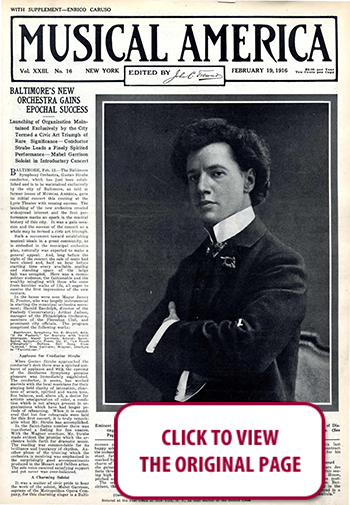 100 YEARS AGO IN MUSICAL AMERICA (131)
100 YEARS AGO IN MUSICAL AMERICA (131)
February 19, 1916
Page 1
BALTIMORE’S NEW ORCHESTRA GAINS EPOCHAL SUCCESS
Launching of Organization Maintained Exclusively by the City Termed a Civic Art Triumph of Rare Significance—Conductor Strube Leads a Finely Spirited Performance—Mabel Garrison Soloist in Introductory Concert
BALTIMORE, Feb. 12.—The Baltimore Symphony Orchestra, Gustav Strube conductor, which has just been established and is to be maintained exclusively by the city of Baltimore, as told in former issues of MUSICAL AMERICA, gave its initial concert this evening at the Lyric Theater with rousing success. The launching of the new orchestra created widespread interest and the first performance marks an epoch in the musical history of this city. It was a gala occasion and the success of the concert as a whole may be termed a civic art triumph.
Such a movement toward establishing musical ideals in a great community, as is embodied in the municipal orchestra plan, naturally was expected to make a general appeal. And, long before the night of the concert the sale of seats had been closed and, half an hour before starting time every available seating and standing space of the large hall was occupied. Here was a cosmopolitan audience, the fashionable and the wealthy mingling with those who come from humbler walks of life, all eager to receive the first impressions of the new venture.
In the boxes were seen Mayor James H. Preston, who was largely instrumental in starting the municipal orchestra movement; Harold Randolph, director of the Peabody Conservatory; Arthur Judson, manager of the Philadelphia Orchestra, members of the Florestan Club, and prominent city officials. The program comprised the following works:
Beethoven, Symphony No. 8; Mozart, Aria, “II Re Pastore,” for Soprano with Violin Obbligato, Mabel Garrison, Soloist; Saint· Saëns, Symphonic Poem, Op. 51, “ Le Rouet d’Omphale”; Delibes, Bell Song from “Lakmé,” Miss Garrison; Wagner, Overture to Tannhäuser.”
Applause for Conductor Strube
When Gustav Strube approached the conductor’s desk there was a spirited outburst of applause and with the opening of the Beethoven Symphony genuine pleasure was immediately established. The conductor, it seems, has worked marvels with the local musicians for their playing held clarity of intonation, clear ness of attack, spirited and warm tone, fine balance, and, above all, a desire for artistic amalgamation of color, a condition which is not always present in organizations which have had longer periods of rehearsing. When it is considered that but few rehearsals were held for this first concert, it is truly remarkable what Mr. Strube has accomplished.
In the Saint-Saëns number there was manifested a feeling for fine nuance. With the Wagner overture, Mr. Strube made evident the promise which the orchestra holds forth for dramatic music. The reading was commendable for its brilliance and buoyancy of rhythm. Another phase of the training which the orchestra is receiving was emphasized in the surprisingly good accompaniments produced in the Mozart and Delibes arias. The solo voice received satisfying support and yet never was over-balanced.
A Charming Soloist
It was a matter of civic pride to hear the work of the soloist, Mabel Garrison, soprano of the Metropolitan Opera Company, for this charming singer is a Baltimorean and naturally proved a very happy selection for the inauguration of the orchestra. Miss Garrison met with instant favor. The Mozart aria was marked by beauty of tone, flexibility and charm of style, while in the “Bell Song” she gained some unusually brilliant effects through her roulades and fascinating high tones, all of which were truly pitched and pure in quality. The orchestra comprises local musicians, the membership numbering fifty players, four of whom have been drawn from the forces of the neighboring orchestra in Philadelphia. These outside players represent two horns, a bassoon and a double bass. The remaining membership is of young and energetic Baltimoreans who have received their musical training and experience in local conservatories. The fact that the orchestra has been established upon such a high plane in so short a period reflects a very large measure of credit to the individual performers as well as to the painstaking efforts of the conductor. Joan C. van Hulsteyn is the concertmaster; Shepherd S. Pearson is the orchestral representative, and John Itzel is the librarian.
Manager Huber’s Success
The management of the orchestra is under the care of Frederick H. Huber, who has every reason to feel gratified with the enormous success which has followed his energetic campaign for its formation. After the concert, Mayor Preston and Gustav Strube were the honored guests at the Florestan Club, where the new venture was pronounced a most significant feature in the history of musical advance locally. Speeches were made by the Mayor, the president of the club, Harold Randolph, Frederick H. Gottlieb and the Rev. Mr. Hoffmann. One of the unique features of the new venture was the open rehearsal given to the students of the Baltimore City College on Wednesday morning. The program was played in its entirety. —FRANZ C. BORNSCHEIN.




 RENT A PHOTO
RENT A PHOTO





